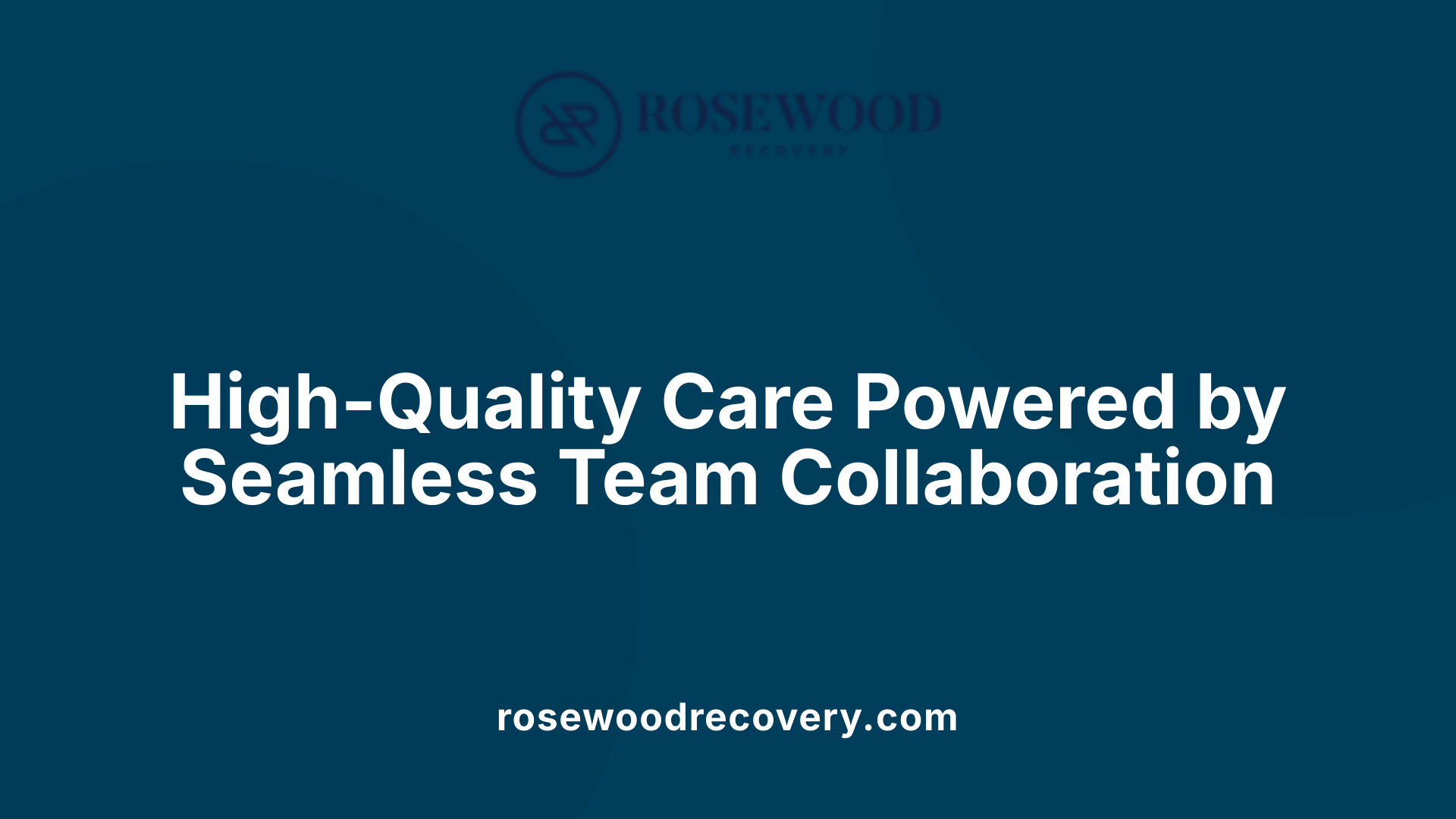Understanding the Power of Licensed Multidisciplinary Teams
In today's complex healthcare environment, the integration of licensed multidisciplinary treatment teams has become a cornerstone for delivering high-quality, patient-centered care. These teams bring together professionals from diverse specialties, leveraging their collective expertise to enhance diagnosis, treatment, and long-term wellness. This article explores the manifold benefits of licensed multidisciplinary teams, emphasizing their role in improving patient outcomes, operational efficiency, safety, and overall care quality.
The Structure and Composition of Multidisciplinary Care Teams

What is the role of multidisciplinary teams in improving diagnosis, treatment, and long-term wellness?
Multidisciplinary teams (MDTs) are vital in enhancing healthcare outcomes across a range of complex health conditions. They bring together diverse professionals—such as doctors, nurses, therapists, social workers, and specialists—to collaborate on patient care. This collective effort ensures more accurate diagnoses by pooling expertise and conducting comprehensive assessments.
In treatment, MDTs facilitate personalized care plans that consider all facets of a patient’s health, including physical, emotional, and social factors. Their teamwork reduces errors, expedites treatment initiation, and enhances adherence to evidence-based practices. For long-term wellness, these teams support ongoing management, lifestyle adjustments, and prevent relapse through continuous coordination.
Standardized protocols, clear communication channels, and strong team leadership are fundamental. They enable seamless collaboration and swift decision-making, which are crucial in managing complex, chronic, or life-threatening conditions such as cancer, cardiovascular disease, and mental health issues.
By embedding technology like cloud-based electronic health records, MDTs ensure all members access real-time data, fostering transparency and efficiency. This approach not only improves patient safety but also boosts staff development through shared learning experiences.
Ultimately, multidisciplinary teams are central to delivering holistic, patient-centered care, leading to better health outcomes, increased patient satisfaction, and more efficient resource use. Their structured collaboration creates a supportive environment where continuous improvement in diagnosis, treatment, and wellness is possible.
Collaborative Functioning: A Pillar of High-Quality Care

Why is team composition, collaboration, and functioning important in multidisciplinary care?
Effective multidisciplinary care hinges on well-organized team members working seamlessly together. The right mix of healthcare professionals—from doctors and nurses to specialists like pharmacists, therapists, and social workers—ensures comprehensive and holistic treatment planning tailored to complex patient needs.
Clear communication among team members is essential. It allows for accurate sharing of patient information, real-time updates, and swift decision-making. When team members trust each other and respect diverse expertise, they foster an environment where challenging questions and innovative ideas can thrive.
Leadership also plays a vital role. Strong leaders coordinate efforts, set shared goals, and keep the team aligned. This clarity supports shared decision-making, where the patient benefits from a unified, personalized care plan.
Standardized protocols and procedures are important for consistency and safety. These frameworks guide team actions, reduce errors, and streamline care delivery.
Overcoming logistical hurdles is another challenge. Effective teams adopt strategies like scheduled meetings, shared electronic health records, and structured communication tools to address resource limitations and organizational barriers.
Ultimately, high-functioning teams enhance patient outcomes by reducing errors, improving safety, and delivering care that adapts to evolving patient needs. Their collaborative spirit is fundamental to high-quality, patient-centered healthcare.
Benefits of Licensed Multidisciplinary Teams for Patients and Staff

What are the benefits of a licensed multidisciplinary treatment team in healthcare?
Licensed multidisciplinary teams in healthcare bring together experts from various fields to provide comprehensive, patient-centered care. This collaborative approach enhances the accuracy of diagnoses and the effectiveness of treatment plans because multiple specialists review cases, reducing the risk of misdiagnosis or overmedication.
By integrating diverse expertise, these teams improve communication and coordination, which minimize errors and adverse events during treatment episodes. This leads to safer patient environments, fewer complications, and shorter hospital stays.
Patients experience greater satisfaction and better health outcomes because their care addresses physical, mental, and social needs holistically. For example, in oncology and surgery, multidisciplinary teams can swiftly plan and execute treatment strategies, often enabling more timely and tailored interventions.
For healthcare staff, working within licensed multidisciplinary teams supports professional growth and job satisfaction. Members learn from each other, share responsibility, and develop broader skills, contributing to a positive work environment.
Implementation of these teams promotes efficiency by reducing unnecessary tests, repeat procedures, and resource wastage. Overall, licensed multidisciplinary care ensures a harmonized approach to treatment, optimizing health resources and improving long-term patient well-being.
Enhancing System Efficiency and Patient Support

How do multidisciplinary teams contribute to system efficiency, patient support, and treatment recommendations?
Multidisciplinary teams boost healthcare system efficiency and enhance patient support through comprehensive, coordinated care. By bringing together professionals from various fields, such as physicians, nurses, therapists, and social workers, these teams foster improved communication and teamwork. This collaboration ensures that treatment plans are personalized, evidence-based, and quickly devised, which shortens delays and reduces unnecessary procedures.
Effective communication within the team minimizes medical errors, prevents duplication of tests, and streamlines resource use. Regular team meetings and shared access to electronic health records enable real-time information sharing, supporting consistent and accurate treatment decisions.
Patients benefit from holistic care that considers their physical, emotional, and social needs. This approach increases satisfaction, improves adherence to treatment, and enhances health outcomes. Furthermore, multidisciplinary teams support ongoing management of chronic illnesses and complex cases, leading to better long-term health and quality of life.
In essence, these collaborative efforts not only optimize resource utilization but also create a more efficient, patient-centered healthcare environment that delivers timely, tailored, and safe care.
Operational Insights and Guiding Principles for Effectiveness

What operational insights and guidelines can ensure effective multidisciplinary team structures?
Creating a successful multidisciplinary team (MDT) hinges on thoughtful operational strategies. First, clarity in roles and responsibilities is vital. Each team member should understand their specific function and how it contributes to the overall patient care plan. Clear leadership or coordination fosters trust, mutual respect, and a safe environment for open dialogue.
Shared goals are also critical. When all professionals align on common objectives, collaboration becomes more streamlined and effective. This shared vision supports unified decision-making and patient-centered outcomes.
Adequate infrastructure, including dedicated meeting spaces, advanced communication tools, and organized governance frameworks, ensures smooth interactions. Regular team meetings and structured processes, such as case reviews or MDT meetings, promote ongoing coordination.
To maintain high-quality decisions, implementing evaluation tools like MDT-MODe or MDT-QuIC can identify areas for improvement and help uphold decision-making standards. These assessments facilitate continuous improvement in team functioning.
Involving all relevant stakeholders—medical specialists, psychosocial providers, patients, and family members—enhances the comprehensiveness of care. This inclusive approach supports holistic treatment, addressing both medical and social determinants of health.
Staff training is essential. Regular education on team dynamics, communication skills, and clinical updates ensures the team remains competent and well-prepared. Organizational support, such as protected time for meetings and clear boundaries for responsibilities, sustains team effectiveness.
Overall, embracing these operational principles—role clarity, shared goals, supportive infrastructure, stakeholder involvement, and ongoing training—optimizes multidisciplinary team performance and leads to improved patient outcomes.
The Role of Multidisciplinary Teams in Diagnosing and Promoting Long-Term Wellness

What is the role of multidisciplinary teams in improving diagnosis, treatment, and long-term wellness?
Multidisciplinary teams are essential in delivering comprehensive, accurate healthcare. These teams bring together diverse professionals such as physicians, nurses, therapists, social workers, and specialists, enabling a holistic approach to patient care. Their collaborative effort improves diagnosis by integrating different perspectives and expertise, reducing errors and oversight.
In treatment, such teams develop personalized plans that consider all aspects of a patient’s health—physical, emotional, and social. This leads to better health outcomes, quicker recoveries, and fewer complications. For chronic conditions like diabetes, cardiovascular disease, and cancer, multidisciplinary teams coordinate ongoing management, adjust treatments, and support lifestyle changes.
Furthermore, these teams focus on long-term wellness by promoting continuous care, patient engagement, and education. They ensure that patients receive consistent support, follow-up, and access to ancillary services such as physical therapy, nutrition, and mental health support.
Addressing physical, emotional, and social factors is central to their approach. This comprehensive perspective helps in managing co-occurring conditions, mental health issues, and social determinants of health, promoting sustainable health and enhanced quality of life.
Staff collaboration is reinforced through regular meetings, shared electronic health records, and ongoing training, including simulation-based learning. This teamwork not only improves patient safety and satisfaction but also supports staff development and workplace morale.
In summary, multidisciplinary teams are vital in diagnosing complex conditions accurately, creating tailored treatment strategies, and fostering long-term wellness by integrating physical care with emotional and social support. Their role in healthcare continues to grow, emphasizing the importance of coordinated, patient-centered approaches to improve outcomes and lifelong health.
Impact Across Healthcare Fields and Specialties

What are the benefits of multidisciplinary approaches in fields such as mental health, elder care, cancer care, or diabetes management?
Multidisciplinary approaches provide substantial advantages across many healthcare areas by integrating a team of diverse specialists aiming for comprehensive patient care. In mental health, these teams include psychiatrists, psychologists, therapists, and family support specialists (FSS), who work together to address emotional, physical, and social factors, leading to better clinical outcomes and higher caregiver satisfaction.
In elder care, multidisciplinary teams often comprise nurses, physicians, social workers, and rehabilitation therapists. This collaboration enhances case management, reduces service gaps, and ensures a holistic approach to aging-related health issues, improving survival rates and quality of life.
Cancer treatment benefits significantly from MDTs involving oncologists, radiologists, surgeons, genetic counselors, and psychosocial support staff. Such teams foster personalized treatment plans, facilitate adherence to guidelines, and often result in improved survival rates and patient satisfaction.
Diabetes management illustrates the importance of a multidimensional team, including primary care physicians, endocrinologists, dietitians, mental health professionals, and community health workers. This group coordinates medication management, lifestyle interventions, and ongoing support, which collectively reduce complications, decrease hospitalizations, and enhance patient quality of life.
Overall, the use of multidisciplinary teams leads to more accurate diagnoses, better treatment outcomes, and increased patient engagement. They improve communication among providers, reduce errors, and promote seamless care transitions. By addressing the complete spectrum of patient needs, these approaches not only improve health results but also optimize the use of healthcare resources.
Implementing such models results in shorter hospital stays, fewer complications, and reduced healthcare costs. Patients and healthcare providers alike benefit from enhanced collaboration, leading to a more efficient and satisfying care experience. The integrated, patient-centered approach fosters innovation and effective management tailored to each individual’s unique health journey.
Impact of Multidisciplinary Care on Patient Outcomes, Safety, and Care Quality
 Multidisciplinary teams play a crucial role in enhancing patient outcomes, safety, and the overall quality of healthcare. Evidence from various studies shows that collaborative healthcare models lead to better management of complex conditions, reduced complications, and higher patient satisfaction.
Multidisciplinary teams play a crucial role in enhancing patient outcomes, safety, and the overall quality of healthcare. Evidence from various studies shows that collaborative healthcare models lead to better management of complex conditions, reduced complications, and higher patient satisfaction.
Research indicates that relative to traditional care, multidisciplinary approaches decrease hospital readmissions, shorten lengths of stay, and improve recovery rates. For instance, in stroke units, patients cared for by dedicated teams are more likely to regain independence and live at home after a year. Similarly, in cancer care, multidisciplinary tumor boards accelerate diagnosis, personalize treatment plans, and improve survival rates.
One of the main ways multidisciplinary teams improve safety is through enhanced communication and coordination. Regular team meetings, shared electronic health records, and standardized protocols reduce medication errors, prevent unnecessary tests, and minimize adverse events such as infections or pressure ulcers. Safety initiatives like surgical 'Time Out' procedures and simulation training contribute further to error reduction.
Additionally, multidisciplinary teams foster a safety culture that supports continuous improvement. Staff training programs and team-based care protocols enhance awareness and adherence to safety practices. In ICU settings, nursing care emphasizing proper medication management prevents complications like ICU psychosis.
Patients benefit from this cohesive approach through higher satisfaction and faster recovery. When providers work together seamlessly, patients experience fewer delays, more comprehensive assessments, and tailored treatments. This collaboration ultimately leads to a higher trust in healthcare delivery and better health outcomes.
| Aspect | Benefit | Additional Details |
|---|---|---|
| Outcomes | Reduced readmissions, mortality, complications | Evidence from stroke and cancer care demonstrates increased survival and independence |
| Safety | Fewer errors, adverse events | Improvements linked to communication, protocols, and staff training |
| Satisfaction | High patient approval, better engagement | Patients report feeling more supported and informed |
Overall, integrating multidisciplinary teams into healthcare systems results in safer, more effective, and patient-centered care, demonstrating their essential role in modern medicine. Online resources and research, such as the search query "Multidisciplinary team impact on patient safety and outcomes," can provide further insights into this impactful approach.
Fostering Enhanced Patient Engagement and Team Competence

What is the significance of licensed multidisciplinary teams in enhancing team competence and patient engagement?
Licensed multidisciplinary teams play a pivotal role in improving both the skills of healthcare providers and the engagement of patients in their care. These teams operate within established standards and protocols that promote clear communication and consistency in treatment approaches.
By adhering to professional licensure and guidelines, team members are better equipped to collaborate effectively, which leads to safer and higher-quality care. Such organization supports comprehensive coordination among diverse specialists, reducing errors and adverse events, and increasing overall patient safety.
Patient involvement is crucial in achieving positive health outcomes. Licensed teams facilitate this through regular meetings, shared care plans, and transparent communication channels. These practices empower patients, offering them a voice in decision-making, thus fostering a patient-centered environment.
Training and simulation exercises are integral to this approach. They strengthen team cohesion, improve communication, and help reduce errors during complex procedures or emergencies. Simulated scenarios also boost provider confidence and foster a culture of continuous improvement.
Furthermore, standardization through protocols ensures that everyone on the team understands their roles and responsibilities, leading to more efficient and predictable care delivery.
In conclusion, licensed multidisciplinary teams create a structured, collaborative, and transparent healthcare environment. This framework enhances team performance, encourages patient active participation, and ultimately results in safer, more effective, and satisfying healthcare experiences for all involved.
Harnessing the Power of Multidisciplinary Teams for Better Healthcare
The integration of licensed multidisciplinary treatment teams in healthcare settings revolutionizes patient care by fostering collaboration, innovation, and comprehensive management of complex health needs. Through well-structured team composition, effective communication, and shared goals, these teams not only enhance safety, efficiency, and outcomes but also promote patient engagement and long-term wellness. As healthcare continues to evolve, investing in the development and support of multidisciplinary teams will be pivotal in achieving higher standards of quality, safety, and patient satisfaction—ultimately transforming healthcare into a more responsive, efficient, and compassionate system.
References
- Challenges and Benefits of a Multidisciplinary Approach to ...
- The Benefits of Multidisciplinary Care - Compleatkidz
- Multidisciplinary in-hospital teams improve patient outcomes: A review
- Benefits of Multidisciplinary Care Teams for Patients - Healthie
- Quality Indicators for Multidisciplinary Team Functioning in ...
- What is a multidisciplinary team in healthcare? (Key benefits) - Indeed
- Elder Justice Initiative (EJI) | 1: Introduction to Multidisciplinary Teams

.jpeg)


